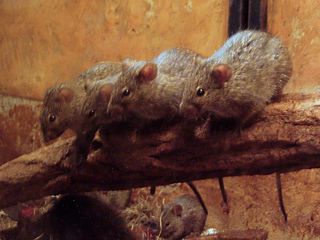
African grass rat
Order : Rodentia
Suborder : Sciurognathi
Family : Muridae
Subfamily : Murinae
Species : Arvicanthis niloticus
The African grass rat is listed as Least Concern. Does not qualify for a more at risk category. Widespread and abundant taxa are included in this category, on the IUCN Red List of Threatened Species
Namings for the African grass rat
A young / baby of a African grass rat is called a 'kitten, nestling, pinkie or pup'. The females are called 'doe' and males 'buck'. A African grass rat group is called a 'colony, horde, pack, plague or swarm'.Countries
Benin, Burkina Faso, Burundi, Central African Republic, Chad, Congo, Democratic Republic of the, Cote d'Ivoire, Egypt, Eritrea, Ethiopia, Gambia, The, Ghana, Kenya, Malawi, Mauritania, Niger, Nigeria, Saudi Arabia, Senegal, Sierra Leone, Sudan, Tanzania, Togo, Uganda and ZambiaAfrican grass rat habitats
Arable Land, Artificial / Aquatic & Marine, Artificial / Aquatic - Irrigated Land (includes irrigation channels), Artificial / Aquatic - Seasonally Flooded Agricultural Land, Artificial / Terrestrial, Dry savanna, Moist savanna, Pastureland, Rural Gardens, Savanna, Shrubland, Subtropical / Tropical Moist Shrubland and Urban AreasSome facts about the
Nile kusu
Adult weight : 0.11 kg (0.242 lbs)
Maximum longevity : 7 years
Female maturity :45 days
Male maturity : 45 days
Gestation : 22 days
Weaning : 23 days
Litter size : 5
Litters per year : 4
Interval between litters : 38 days
Weight at birth : 0.004 kg (0.0088 lbs)
Weight at weaning : 0.022 kg (0.0484 lbs)
Facts about the African grass rat
Most authorities agree that there are probably five distinct species, all hailing from tropical Africa, of which Arvicanthis niloticus is by far the commonest in captivity and realistically the only one you are likely to encounter.
Nile or African grass rat Arvicanthis niloticus is a vole-like rat with a stout body, coarse fur and short legs.
PHD 309 The Nile grass rat (Arvicanthis niloticus) is a common grassland rodent widely distributed in subsaharan Africa and an important reservoir for plague (Yersinia pestis).
The Nile Rat (Arvicanthis niloticus) is being incriminated as the reservoir host for VL in Sudan (Hoogstraal & Heyneman, 1969; El- Hassan et al. (Full text)
The Nile rat (Arvicanthis niloticus) is a serious agricultural pest on some parts of Africa. (Full text)
Most recent taxonomic revisions list five to six species but the definition of some of these (Arvicanthis dembeensis, Arvicanthis nairobae, and Arvicanthis niloticus) is uncertain. (Full text)
More animals beginning with A
